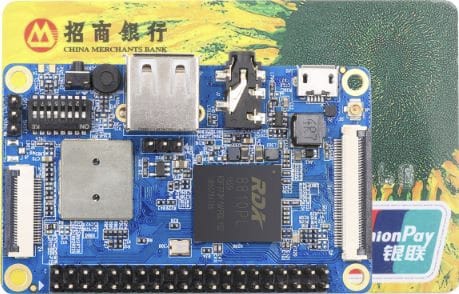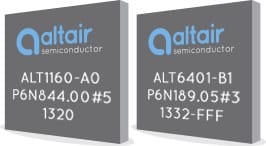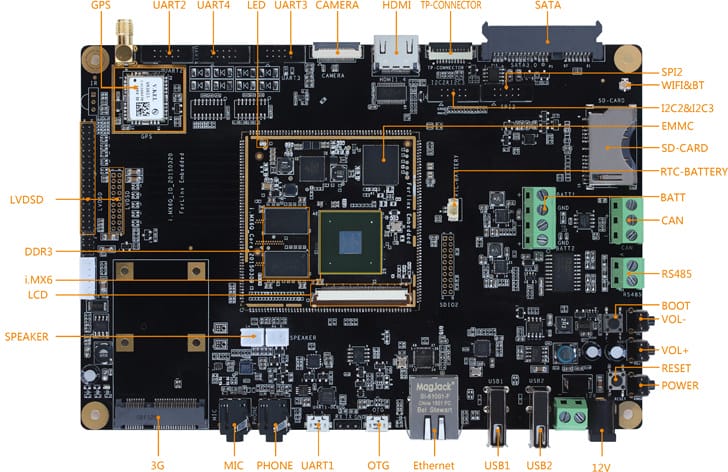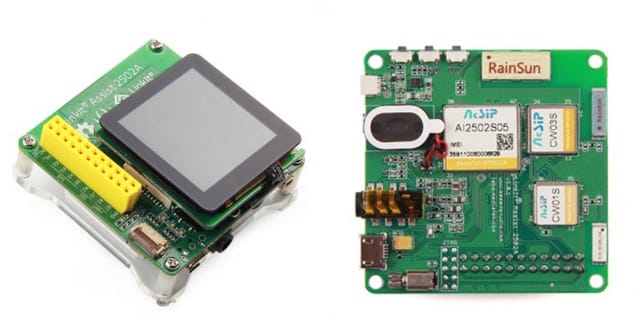Veracruz, Mexico based Verse Technology has recently launched Goblin 2, an Arduino compatible IoT development, based on Atmel/Microchip ATmega328P MCU, featuring a built-in SIM5320A 3G and GPS module, supporting RS-485 communication, and providing 3.3/5 and 24V power output. Goblin 2 board specifications: MCU – Microchip Atmel ATMega328P AVR MCU @ 16 MHz with 1KB EEPROM, 32kB Flash, 2kB SRAM Wireless connectivity via Simcom SIM5320A USB 2.0 module: Dual-Band UMTS/HSDPA 900/2100MHz Quad-Band GSM/GPRS/EDGE 850/900/1800/1900MHz 1x SIM card slot High accuracy 16 channel GPS Expansion I/Os 6x ADC input with 10 bits resolution 10x digital in/out including 5 PWM RS-485 protocol @ 10Mbps for up to 256 nodes on the bus Header to Keypad, microphone and speaker for SIM I/O Misc – 8 LEDs for power, battery, networking, RS485, UART, plus one user LED; Power switch, RS-485 /GPIO switch, program / SIM AT+ switch Power Supply – 5V via micro USB port, […]
$99 Ping is a Tiny GPS Tracker that Works with Bluetooth and Cellular Connectivity (Crowdfunding)
Ping GPS Tracker is really small, last several months on a charge, and works with GPS, Bluetooth, and Cellular (GSM/EDGE or HSPA/UMTS) connectivity. It helps you track kids, pets, bags, keys, bicycles, cars or anything that may be lost or stolen using your iOS or Android smartphone. Ping GPS tracker specifications: Connectivity HSPA/GSM module + embedded 3G module Bluetooth Low Energy module GPS + GLONASS module Sensor – 3-axis accelerometer Misc – Inset tactile button for check-in & SOS, LED activity indicator Battery – 300 mAh custom lithium ion battery good for about 3 months Dimensions – 34 x 34 x 12 mm (PMMA silicone & elastomer materials) Weight – About 30 grams Waterproof – Up to 10 meters You’d use GPS + cellular connectivity when you are far from the tracked asset, and Bluetooth to locate it when it’s close. A button allows for your kid to send a […]
Orange Pi 2G-IOT Board Based on RDA8810PL Cortex A5 Processor to Support Bluetooth and GSM
[Update: The board featured below was initially announced as Orange Pi Zero Plus, but considering it may have confused people as it is not at all compatible with Orange Pi Zero, it has been renamed to Orange Pi 2G-IoT] Linaro mentioned Orange Pi i96 board last fall at Linaro Connect US. It was supposed to be a $9.99 board powered by an RDA Micro Cortex A5 processor with 2Gbit RAM and 4Gbit NAND flash on-chip. There has not been any news since then, but Shenzhen Xunlong has apparently gone ahead with an RDA Micro Cortex A5 board since they’ve posted some pictures of Orange Pi Zero Plus (Note: very slow server) with an RDA Micro ARM Cortex A5 processor. Orange Pi 2G-IoT preliminary specifications: SoC – RDA Micro 8810PL ARM Cortex A5 processor @ up to 1.0 GHz with 2Gbit (256 MB) on-chip LPDDR2 RAM, 4Gbit (512 MB) on-chip SLC […]
Kondor AX FPGA + ARM Networking Board Targets Base Stations, IoT Gateways and IP Cameras
Mikro Project, a company based in Zagreb, Croatia, has recently introduced Kondor AX “Advanced System Development Board” combining Freescale i.MX6Solo processor with Lattice ECP5 FPGA, and targeting “low power applications at the network edge including HetNet (Heterogeneous Networks), Small Cells, Industrial IoT gateways and IP Cameras.” Kondor AX development board specifications: Category Lattice ECP5 LFE5UM-85F-BG756 FPGA Freescale i.MX6 Solo SoC Description 84.000 LUTs 207 Block RAMs 156 18×18 Multipliers 365 IO pins 4 SERDES channels (In/out) 400 MHz LPDDR3 Memory Support 4 PLLs, 4 DLLs ARM Cortex A9 @ 1 GHz 512 KB L2 cache GPU 3D – Vivante GC880 Video Decode: 1080p30 + D1 Video Encode: 1080p30 H.264 BP/ Dual 720p encode Programming options On-board USB JTAG interface 10-pin JTAG header Using i.MX6 processor Memory & Storage 512MB LPDDR3-1600 800 MHz Clock Rate 1x 32-bit channel 512 MB 32-bit DDR3 64Mbit SPI Flash 8GB eMMC Micro SD Card Connectivity […]
Altair FourGee LTE Chipsets Promise 10 Years of Connectivity with AA Batteries for IoT Applications
Connectivity achieved with GSM,. 3G or LTE (4G) cellular networks is great for long distances, but usually costs and power consumption are too high for IoT or M2M communications, which explains why there are competing long range low power WAN standards such as Sigfox, LoRA or Weightless. Altair Semiconductor introduced two new LTE SoCs, namely FourGee-1150/6410 and FourGee-1160/6410 a few months ago, supporting respectively LTE Cat-0 and Cat-1 connectivity, and promising up to 10 years of battery life on AA batteries for smart meters, wearables, security alarms, city lightings, etc… Altair FourGee-1150 and FourGee-1160 key features and specifications: Processor – Multiple MIPS M5150 “Warrior” MCU cores LTE Connectivity FourGee-1150 LTE Release 12 Category-0 (1Mbps / 1Mbps), software upgradeable for supporting Release 13 features Integrated VoLTE/IMS/OTA-DM functionality FourGee-1160 LTE Release 11 Category-1 (10Mbps / 5Mbps), software upgradeable for supporting Releases 12 and 13 features Integrated VoLTE/IMS/OTA-DM with HD voice functionality Software […]
RePhone Kit Create is a DIY Phone and Cellular Development Kit (Crowdfunding)
Seeed Studio has design a modular and open source phone it calls RePhone Kit Create. The kit allows you, or/and your kid(s), to assemble their own phone based on building blocks including a 2G or 3G core module, a touchscreen display module, an audio module, and pre-cut, seawable, washable, and easily drawable Kraft paper to make the case. The kit can also be used for IoT applications using cellular and Bluetooth connectivity, and extra Xadow modules GPS, NFC, motion sensors, camera and more.. Two cellular “core” module can be used: RePhone GSM + BLE module with the “world’s smallest System-on-Chip (SOC) for Wearables and Internet Of Things”, GSM, GPRS and Bluetooth 2.1 and 4.0 support. RePhone Core Module 3G with a “powerful microcontroller”,a standard Xadow interface (USB, GPIO, I2C, SPI, UART, EINT), support for speaker, two microphones and a headset, a Nano SIM, and support for HSPA/WCDMA:850/1900 and GPRS/EDGE:850/1900. Voltage: […]
Forlinx Embedded Introduces a Features-packed Freescale i.MX6 Industrial Board
Forlinx Embedded Technology has made several ARM9, ARM11, and Cortex A8 boards in the past, and they’ve now launched their first ARM Cortex-A9 board powered by Freescale i.MX6 Quad processor with 1GB RAM, 8GB eMMC Flash, HDMI, LCD, and LVDS interfaces, mPCIe connector for 3G module, SATA, GPS, CAN bus, RS485 port, and more. The board is composed of a baseboard and a 220-pin CPU module (soldered) with the following combined specifications: SoC – Freescale i.MX6 Quad with 4x ARM Cortex A9 cores @ up to 1.2 GHz and Vivante GC2000 3D GPU System Memory – 1GB DDR3 Storage – 8GB eMMC, SATA connector, and SD card slot up to 32GB Video Output / Display I/F – HDMI 1.4, LCD interface (7″ capacitive touch available), and 2x 8-bit LVDS interface. 4-wire resistive touch. Audio – 1x stereo audio jack, 1x mono microphone jack, 2x speaker headers Camera I/F – 1x […]
Mediatek LinkIt Assist 2502 Open Source Hardware Board Targets Wearables and IoT Applications
After LinkIt ONE, Mediatek Labs has introduced a new IoT development kit based on their Aster M2502 ARM7 processor with LinkIt Assist 2502 comprised of AcSiP MT2502A IoT SiP Core module, a 802.11b/g/n module, a GNSS module, and an exchangeable 240×240 16-bit color capacitive touch LCM Board. The AcSiP module can also be purchased separately, so you could use LinkIt Assist 2502 board for early development, because moving to your custom hardware based on AcSiP MT2502A module. LinkIt Assist 2502A specifications: MCU – AcSiP AI2502S05 module with MT2502A (Aster) ARM7 EJ-STM processor @ 260MHz, 4MB RAM, 16MB flash Display – 240×240 LCD module; 16-bit color depth; transflective; based on ST7789S driver IC. Connectivity Wi-Fi 802.11 b/g/n via AcSiP CW01S module based on MT5931 SoC Bluetooth 2.1 SPP and 4.0 GATT dual mode (part of MT2502A) GPS via AcSiP CW03S module based on MT3332 chip supporting GPS, GLONASS, and BeiDou. GSM […]








